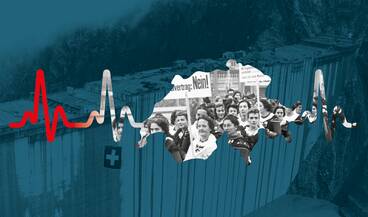Today
10:00 - 17:00
10:00 - 17:00
Tuesday till Wednesday 10:00 - 17:00
Thursday 10:00 - 19:00
Friday till Sunday 10:00 - 17:00
Monday closed
Tuesday till Wednesday and Friday 10:00 - 18:00
Thursday 10:00 - 19:00
Saturday till Monday closed
Good Friday 03.04.2026 10:00 - 17:00
Kars Saturday 04.04.2026 10:00 - 17:00
Easter 05.04.2026 10:00 - 17:00
Easter Monday 06.04.2026 10:00 - 17:00
Sechseläuten 20.04.2026 closed
Labour Day 01.05.2026 10:00 - 17:00
Ascension Day 14.05.2026 10:00 - 17:00
Whitsun 24.05.2026 10:00 - 17:00
Whit Monday 25.05.2026 10:00 - 17:00
Swiss National Holiday 01.08.2026 10:00 - 17:00
Long Night of the Museums 05.09.2026 10:00 - 17:00
18:00 - 23:59
Long Night of the Museums 06.09.2026 0:00 - 2:00
10:00 - 17:00
Knabenschiessen 14.09.2026 closed
Family Day 18.10.2026 10:00 - 17:00
21.12.2026 10:00 - 17:00
22.12.2026 10:00 - 17:00
23.12.2026 10:00 - 17:00
Christmas Eve 24.12.2026 10:00 - 14:00
Christmas 25.12.2026 10:00 - 17:00
St. Stephen´s Day 26.12.2026 10:00 - 17:00
27.12.2026 10:00 - 17:00
28.12.2026 10:00 - 17:00
29.12.2026 10:00 - 17:00
30.12.2026 10:00 - 17:00
New Year´s Eve 31.12.2026 10:00 - 17:00
New Year´s Day 01.01.2027 10:00 - 17:00
Saint Berchtold 02.01.2027 10:00 - 17:00
accessibility.openinghours.special_opening_hours.link
Show all10:00 - 17:00
Tuesday till Wednesday 10:00 - 17:00
Thursday 10:00 - 19:00
Friday till Sunday 10:00 - 17:00
Monday closed
Tuesday till Wednesday and Friday 10:00 - 18:00
Thursday 10:00 - 19:00
Saturday till Monday closed
Good Friday 03.04.2026 10:00 - 17:00
Kars Saturday 04.04.2026 10:00 - 17:00
Easter 05.04.2026 10:00 - 17:00
Easter Monday 06.04.2026 10:00 - 17:00
Sechseläuten 20.04.2026 closed
Labour Day 01.05.2026 10:00 - 17:00
Ascension Day 14.05.2026 10:00 - 17:00
Whitsun 24.05.2026 10:00 - 17:00
Whit Monday 25.05.2026 10:00 - 17:00
Swiss National Holiday 01.08.2026 10:00 - 17:00
Long Night of the Museums 05.09.2026 10:00 - 17:00
18:00 - 23:59
Long Night of the Museums 06.09.2026 0:00 - 2:00
10:00 - 17:00
Knabenschiessen 14.09.2026 closed
Family Day 18.10.2026 10:00 - 17:00
21.12.2026 10:00 - 17:00
22.12.2026 10:00 - 17:00
23.12.2026 10:00 - 17:00
Christmas Eve 24.12.2026 10:00 - 14:00
Christmas 25.12.2026 10:00 - 17:00
St. Stephen´s Day 26.12.2026 10:00 - 17:00
27.12.2026 10:00 - 17:00
28.12.2026 10:00 - 17:00
29.12.2026 10:00 - 17:00
30.12.2026 10:00 - 17:00
New Year´s Eve 31.12.2026 10:00 - 17:00
New Year´s Day 01.01.2027 10:00 - 17:00
Saint Berchtold 02.01.2027 10:00 - 17:00
accessibility.openinghours.special_opening_hours.link
Show allBegegnung
In der Nachkriegszeit erlebte die Schweiz einen regelrechten Boom im Wasserkraftwerksbau: Zwischen 1953–1971 entstanden 82 Staudämme und in den 1980er-Jahren folgten zahlreiche Projekte für Pumpspeicherkraftwerke. Diese sollten überschüssige Energie – etwa aus Atomkraftwerken – speichern und bei Bedarf wieder abgeben. Doch der Ausbau stiess bald an ökologische und gesellschaftliche Grenzen, wie zum Beispiel beim geplanten Pumpspeicherkraftwerk im Val Madris.
Die Bauherren gingen von wenig Widerstand im unbesiedelten Tal aus. Doch Alphirtinnen und Alphirten sowie Umweltaktivistinnen und Umweltaktivisten machten sich stark und organisierten zahlreichen Protestaktionen. 1995 stoppte das Unternehmen das Projekt wegen ökonomischer Bedenken. Der lokale Widerstand führte 1998 dazu, dass der Bundesrat das Moor im Val Madris unter Schutz stellte und das Projekt endgültig beendete.
Wir sprechen über diesen Abschnitt Schweizer Energiegeschichte – zwischen Aufbruchsstimmung und wachsendem Umweltbewusstsein – mit dem Zeitzeugen Urs Chiara und der Kulturwissenschaftlerin und Publizistin Ina Boesch
Moderation: Marina Amstad, Historikerin und Ausstellungskuratorin
Museumstrasse 2
8021 Zürich
Monday till Friday 09:00 - 12:30

The 1950s saw a sharp rise in demand for electricity, including in Switzerland. Dams started to be built in the Alps on a grand scale. Once-in-a-generation projects such as the Grande Dixence dam, but also the flooding of the village of Marmorera in 1954 and the Mattmark disaster in 1965, fundamentally changed the lives of people in the Alpine regions. The video installation looks at the economic momentum, recalls the political disputes and addresses the logistical challenges. Contemporary witnesses talk about their various experiences relating to hydropower in the Alps, from the incredible feats of engineering to the tough working conditions on the construction sites. They describe the expansion of the infrastructure, but also how it impacted the world they lived in. And they look back at the resistance movement that developed against resettlement and at the calls for environmental protection.
About the format
Sometimes objects fail to tell the full story behind formative developments in Switzerland’s recent past. The ‘Experiences of Switzerland‘ format focuses on contemporary witnesses. Their fates and experiences, which in most cases are not found in any archives or records, provide visitors with a multifaceted and emotional insight into Swiss history. Featuring a different topic every year, the format does away with exhibits and consists of a large-format, immersive projection with sound delivered through headphones. Meanwhile, an exploration station features information on the latest research findings in the area and places the topic in its cultural-historical context.